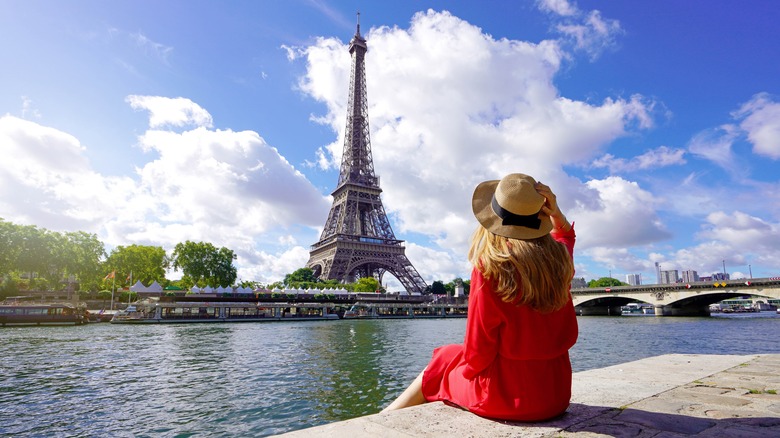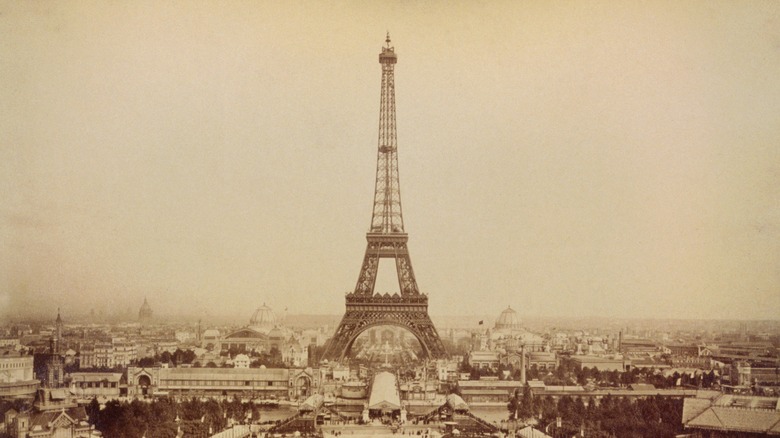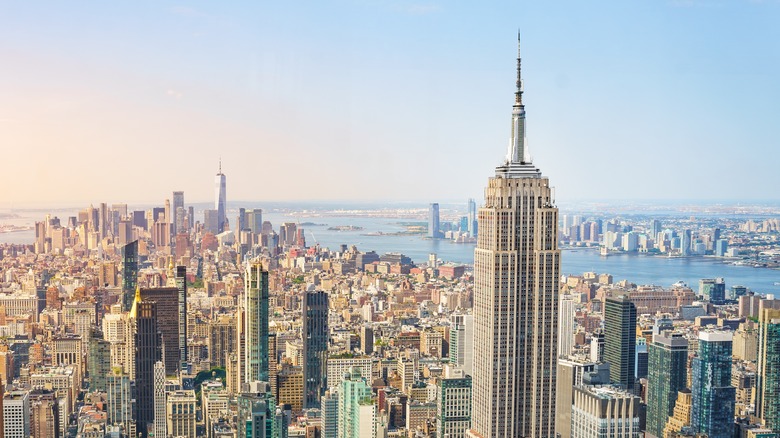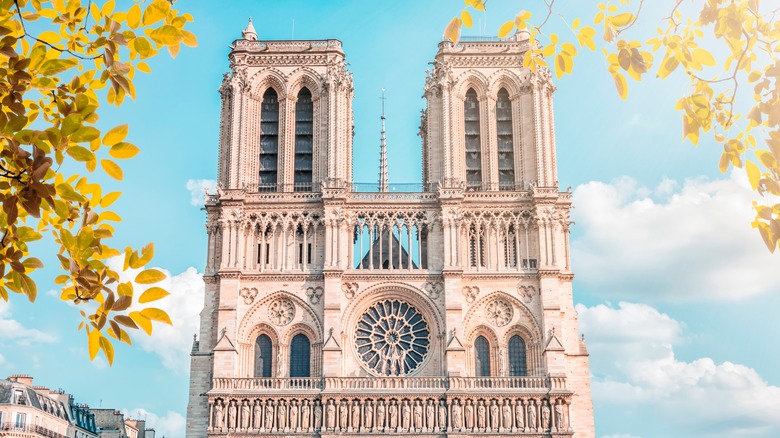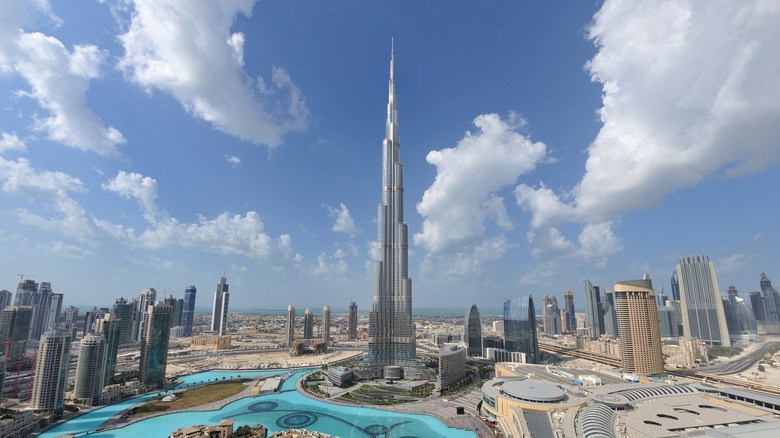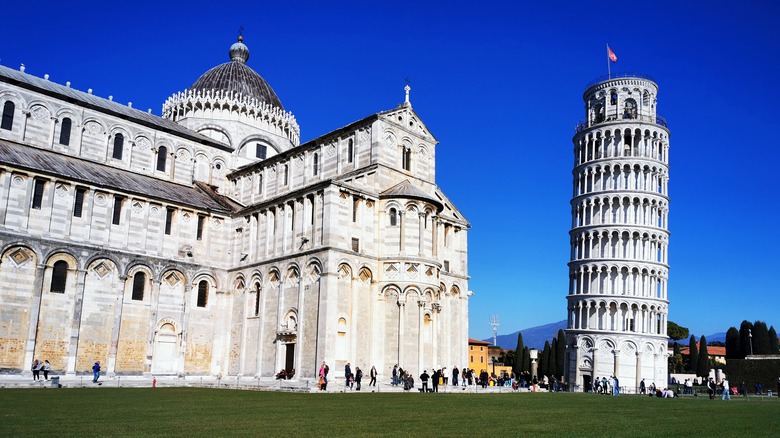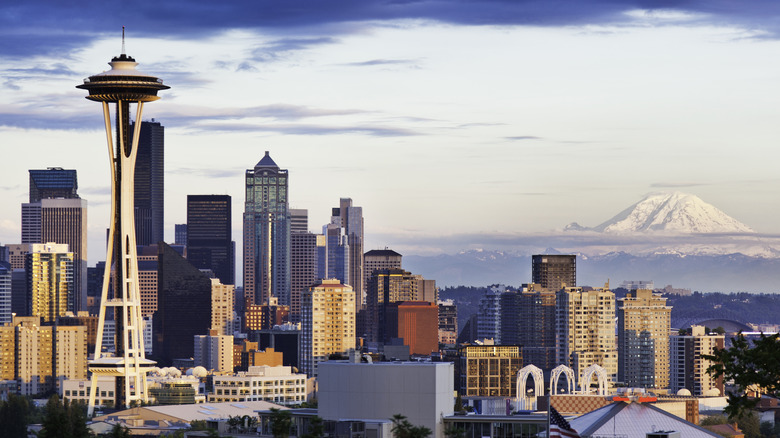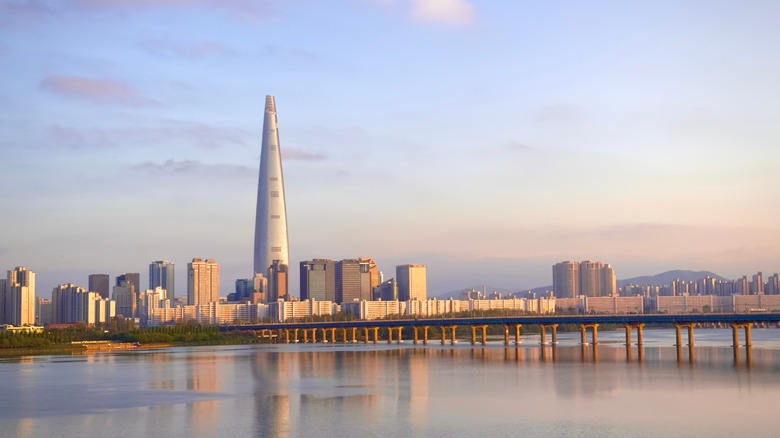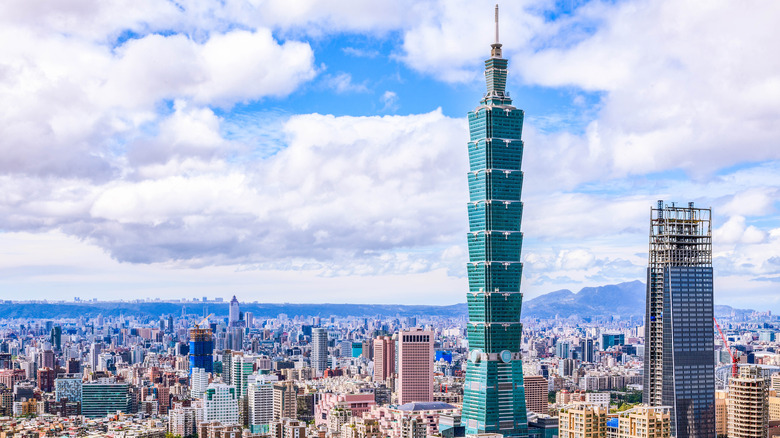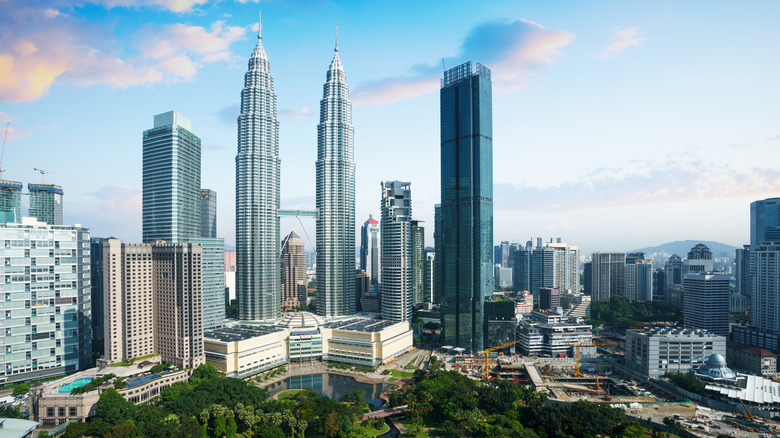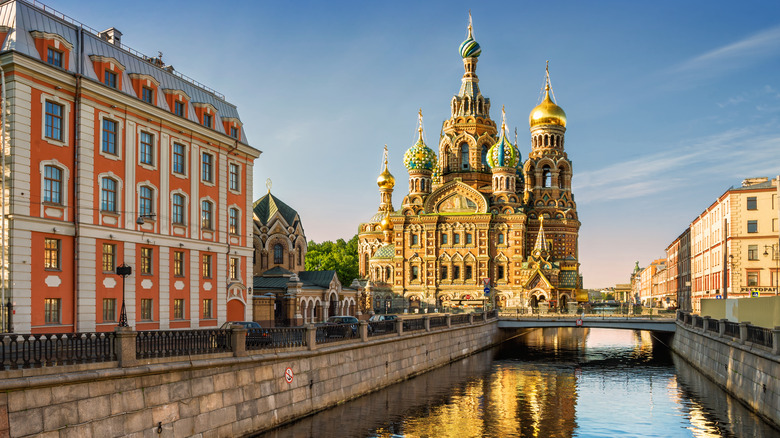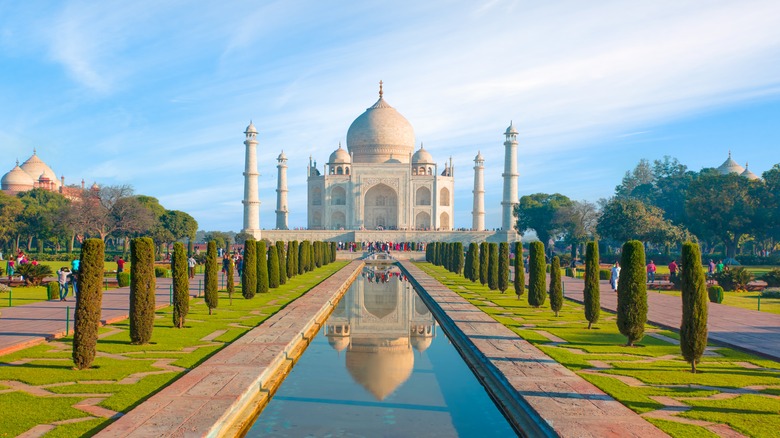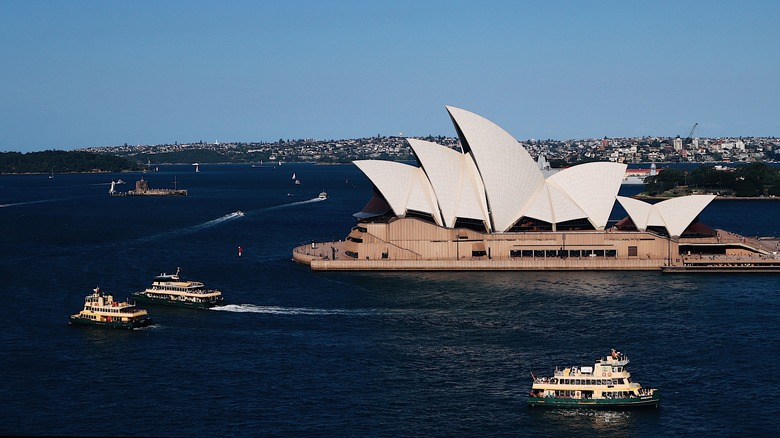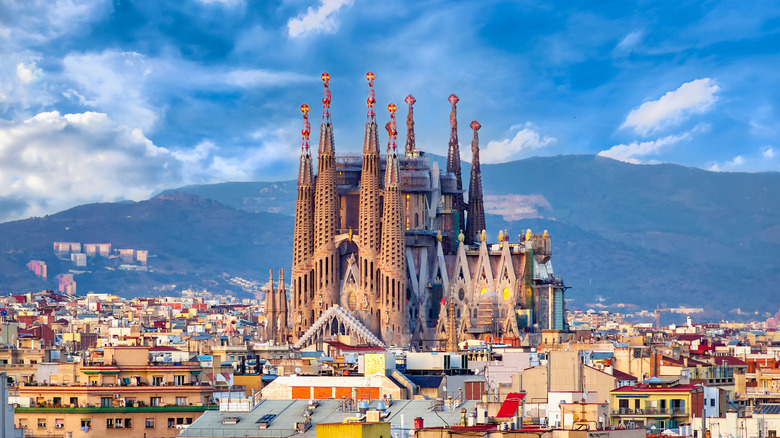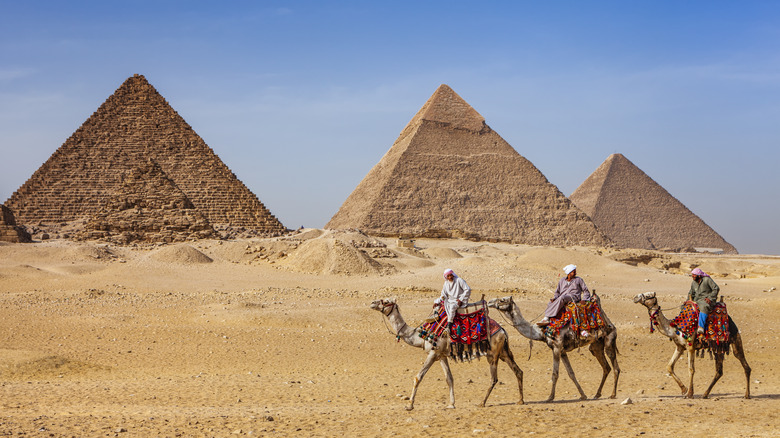The Eiffel Tower's Height Compared To Other Iconic Structures
Most know that the Statue of Liberty was a gift from France to the young United States of America in 1885 as a physical reminder of their alliance. However, many may not be aware that this (very French) American monument shares DNA with one of the most iconic structures on the other side of the globe: the Eiffel Tower. That's because the metalworking engineer Alexandre-Gustave Eiffel helped redesign Lady Liberty's metallic innards after her original structural engineer suffered an untimely death. A few years later, Eiffel put all his efforts into building the Eiffel Tower, which is now so key to the Parisian skyline that the city might be unrecognizable to outsiders without it.
Despite being hundreds of years younger than the city it sits in, the Eiffel Tower has proven how a single edifice can — to a degree — represent and define a nation. It invites comparisons to buildings across the world that also serve as a cultural bedrock for its natives. How tall is the Eiffel Tower, and how does it compare to other architectural icons that span the globe?
How tall is the Eiffel Tower?
Originally, Gustav Eiffel envisioned the tower as an even 300 meters (984 feet) tall — and planned to name it "The 300-meter tower" — but the final design clocked in at a cool 312 meters (1,023 feet). It has three public levels in total. In its day, it took the throne as the world's tallest manufactured structure, a title it kept until the Empire State Building came into being 40 years later. Today, it measures 330 meters (1,082 feet) thanks to a series of broadcast antennas tacked on over the years. Since it's made of metal — puddled iron, to be specific — it increases and decreases in height by a couple of millimeters in tune with the seasons. Summer heat causes the metal to expand, while winter cold causes it to contract.
Eiffel built his tower for a very special occasion: the 1889 World Fair, which coincided with the 100th anniversary of the French Revolution and nearly 20 years into the tenure of the newly-minted French Third Republic. It took just over two years to complete. Having the world's tallest building — and a highly unique one, at that — gave France a symbol of unity and power. Locals weren't all on board at first, but it's clear they became enamored, and people now flock to Paris with a visit to the Eiffel Tower at the top of the docket.
Empire State Building, New York City, New York - 1,454 feet
The Eiffel Tower was only the beginning of a fierce competition to reach the skies. The first skyscraper — a building that requires steel and concrete to reach immense heights — appeared in 1885 with the Home Life Insurance Building, and from then on, buildings continued to get taller and taller. The Empire State Building arose in this rat race as a mid-life pet project of businessman John J. Raskob and politician Al Smith. They bought the site of the original Waldorf Astoria Hotel, demolished it, and then built the Empire State Building in one year and 45 days — a blisteringly fast pace, even by today's standards.
The Empire State Building stands at 1,454 feet (443 meters) if you include the current spire and antenna — which, fun fact, was once going to be an airdock for dirigible airships. It has 103 floors and 73 elevators. Sadly, this architectural marvel was born smack dab in the middle of the Great Depression, leaving its office space at only a fraction of capacity for years. To this day, it continues to house offices and a couple of tourist observation decks. Fans of the "Bioshock"-esque Art Deco art style will love the skyscraper's elaborate interiors — though be aware that it has some of the longest lines in the world.
Notre Dame, Paris, France - 223 feet
Notre Dame made headlines in 2019 when a fire caused significant damage to the building's upper towers. Fortunately, it's set to reopen fully by December 8, 2024. Meaning "Our Lady" in French, construction on the marvel of Notre Dame began in 1163 and continued for almost 200 years until 1345, making it one of many must-see structures that took hundreds of years to build. The idea behind the cathedral was to transform two ruined basilicas into a single building. At its highest point (those iconic two towers), it reaches 223 feet (68 meters). It's a textbook example of Gothic style, and thanks to the architectural ingenuity of flying buttresses, it still stands tall.
Aside from being a beautiful place of worship, some major historical events happened there. Henry VI of England and Napoleon Bonaparte's coronation occurred at Notre Dame, as did Joan of Arc's beatification ceremony. The novel (and well-known Disney movie) "The Hunchback of Notre Dame," unbeknownst to many, was an appeal to the French people not to demolish their cultural heritage in the wake of the bloody French Revolution. Notre Dame is primarily a tourist destination these days, but it will administer Mass when in full operation.
Burj Khalifa, Dubai, United Arab Emirates - 2,716 feet
The Burj Khalifa is a veritable, modern-day Tower of Babel that evidences humanity's engineering prowess. It stands at 2,716 feet tall (828 meters), making it the tallest building of any kind in the world. It has 163 floors, and the curious flower-petal design enables its impressive height and prevents the wind from toppling it over. Construction kicked off in 2004, and officials celebrated the opening in 2010. Visitors can take to multiple public observation decks and get some of the highest manufactured views in the world. People can live, work, shop, and even spend a night during a visit to the Burj Khalifa, making it something approaching a vertical city.
According to the chairman of Emaar Properties, Mohamed Alabbar, the Burj Khalifa project is "a declaration of the Emirate's capabilities and of the resolve of its leaders and people to work hand-in-hand on truly awe-inspiring projects." The Khaleej Times reported that the tower gets a whopping 17 million visitors each year, making it one of the world's most popular landmarks. It will likely keep the title of the world's tallest structure until the Jeddah Tower beats it, an upcoming project that aims to reach one kilometer (3,280 feet) in height, which would be a jaw-dropping 172 meters (564 feet) taller than the Burj Khalifa.
The Leaning Tower of Pisa, Italy - 196 feet
The Leaning Tower of Pisa is one of the world's strangest monuments since it seems like it ought to have fallen over already. And it almost did, multiple times. In 1993, it took an eight-year international effort to correct a dangerous degree of lean. To Italy's misfortune, it's not a new problem. Construction was plagued from the beginning due to a weak, marshy foundation that only manifested once the builders completed the first three levels. A pause in construction due to war may have saved it once already, allowing the lean to self-correct. Still, engineers had to change the tower's design as it went up to account for the lean.
Had it never leaned, the Tower of Pisa would have stood at 60 meters (196 feet) even. The question of how tall the tower is thus depends on where you measure it. Its "high" side (the side tilted up by the lean) measures 56.67 meters (185 feet), while the "low" side (above the lean) measures 55.86 (183 feet). Despite its quirky modern reputation, construction began in 1173 with the intent of simply making a bell tower for Pisa's cathedral complex. And it's not the only one of its kind; multiple towers in Pisa feature a characteristic lean due to that marshy ground.
The Space Needle, Seattle, Washington - 605 feet
The Space Age is characterized by a 1950s zeitgeist of building space-bound rockets and envisioning humanity spreading across the stars. Think "The Jetsons" and "2001: A Space Odyssey," and how everything from cars to homes around the '60s was imitating the "future" aesthetic. That's the environment in which Seattle's Space Needle was born. Edward E. Carlson (chief organizer for the 1962 World's Fair) took inspiration from a sky-high broadcast tower restaurant he saw in Germany circa 1959, and he used a napkin to sketch out his idea.
Fast forward to 1961, and construction had already begun on the Space Needle, finishing the following year just in time to open the World's Fair. That makes it, in a sense, a modern alter ego of the Eiffel Tower. It's 605 feet (184 meters) tall with a panoramic, 360-degree observation deck that arguably gives the best view of Seattle. Thanks to a renovation in 2018, a glass floor was added that lets you look down at Seattle between your feet. Tourism aside, the top antenna also doubles as a radio transmitter for local stations.
Lotte World Tower, Seoul, South Korea - 1,820 feet
South Korea had a turbulent 20th century. First, a brutal Japanese occupation, then WWII, then a devastating civil war that caused famed General Douglas MacArthur to say, "[Korea] has no future." South Korea proved him so wrong that its economic explosion earned it the nickname the "Miracle of the Hangang River." Lotte World Tower isn't just a colossal engineering marvel; it's a visual representation of just how far South Korea has come in less than a century.
Built by the country's massive Lotte Corp conglomerate, it was finished in 2017 and reaches 555 meters (1,820 feet), making it the tallest building on the peninsula and 5th tallest in the world. Its 123 floors are mixed-use, including office space, a hotel, retail stores, and a glass-floored observation deck at the very top. The tower is located in a vast mall complex and saw 55 million visitors in 2023, according to The Korean Economic Daily. If you want to get the highest, best view of Seoul, this is where you go.
Taipei 101, Taipei, Taiwan - 1,667 feet
Taiwan is one of the world's primary sources of semiconductor wafers, making it an economic powerhouse deserving of its own supertall skyscraper. Thus, the Taipei 101 in Taiwan's capital, Taipei. You can identify it by the curious stack of flared sections, the number of which is supposedly inspired by the lucky Chinese number 8. It's likely immediately identifiable to movie buffs since CNN reported it appeared in 92 foreign films in 2013 alone. The Petronas Towers in Malaysia were, for a time, the tallest in the world until Taipei 101 beat them at a finished height of 1,667 feet (508 meters) and 91 floors. Given that the tower's developer and owner is the Taipei Financial Center Corporation, it's clear the building was intended to be Taiwan's financial and trade center.
Like other towers on this list, it's mostly office space with some retail for good measure. What really sets it apart is the state-of-the-art engineering mass damper housed in the building's base. It functions as an immense "pendulum" that counteracts the tower's movement in response to wind or seismic activity — a necessary innovation since Taiwan sits on at least 26 active faults and experiences powerful winds.
Petronas Twin Towers, Kuala Lumpur, Malaysia - 1,479 feet
Before Taipei 101, the Petronas Twin Towers briefly held the record for the world's tallest building from 1998 to 2004. They are a sight to behold if you ever visit the capital of Malaysia, Kuala Lumpur. Their idiosyncratic flower-like shape and identical twin towers with a connecting bridge set them apart from any structure. Each tower measures 451 meters (1,483 feet) at its highest tip, which means they share nearly a kilometer of height between them. Eighty-eight floors house Petronas Oil's offices (owned and operated by the Malaysian government), retail, and a concert hall. The observation deck and sky bridge are a massive pull for tourists, as is the shopping mall.
Then-prime minister Tun Dr. Mahathir Mohamad said, speaking of the Petronas Towers (via Pelli Clarke & Partners), "As an internationally recognized landmark, the PETRONAS Twin Towers symbolize the courage, ingenuity, initiative, and determination, energy, confidence, optimism, advancement and zest of a nation." Aside from the economic reasons and Petronas' desire for a unique headquarters, the towers were an immense source of pride and proof Malaysia could compete on a global scale — this was, to be clear, the first time any skyscraper outside the Western World had broken the height record. Plus, it was a sound strategy to lure in more foreign investment than their neighbors, contributing to the country's efforts to drive tourism.
Church of the Savior on Spilled Blood, Saint Petersburg, Russia - 266 feet
"St. Petersburg is gloomy, St. Petersburg is bleak," goes the introductory song "A Rumor in St. Petersburg" from the cartoon film "Anastasia." Using experience as a guide, the musical isn't far from reality. The chilly city sitting just off the Gulf of Finland cost many builders' lives when Peter the Great decided to locate it as a "window to Europe" on the site of a swamp. But don't let that description put you off. The city is Russia's cultural capital, featuring some of the country's best architecture. The Church of the Savior on Spilled Blood should be at the top of your list of must-see monuments.
As you can tell by the name, this cathedral was built, almost quite literally, on spilled blood (the Russian name is "Spas na krovi," or "Savior on [spilled] Blood"). The revolutionary group "the People's Will" assassinated Czar Alexander II in 1881 on the streets of St. Petersburg. Allegedly, the cathedral rests on the exact spot where Alexander II lost his life, and you can find a small chapel dedicated to him. Alexander III, the former's son, commissioned the construction in 1883. You'll discover it along the canal off of one of St. Petersburg's main avenues, almost tucked away down a side street. It's immediately identifiable by its colorful onion domes, the tallest of which reaches 81 meters (266 feet). In the modern age, it's more of a tourist-centric national museum and less of a cathedral.
Taj Mahal, Agra, Uttar Pradesh, India - 240 feet
The Taj Mahal is arguably India's most recognizable and visited monument, receiving around 3 million visitors annually (per CNN). It's not just some random beautiful building, though. It's a royal mausoleum. Taj means "crown" or "enthronement" in Hindi, so the translation is "Chosen One of the Palace." Emperor Shah Jahān lost his beloved wife, Mumtaz Mahal, to childbirth in 1631. Stricken with grief, he constructed the monument we know today by 1639, with the final touches completed by 1643. It took 20 years to build and drew on inspiration spanning from India to Persia. UNESCO made it a world heritage site in 1983.
The tallest point of the Taj Mahal mausoleum is 240 feet (73 meters) at the top of its largest central dome. If history had gone a bit differently, we might have had two Taj Mahals. The emperor wanted his own mausoleum across the river, identical in structure to his wife's, with a bridge connecting the pair. In 1658, Jahān's son overthrew his father and denied him this wish. Upon passing, the son buried the fallen emperor in the Taj Mahal beside his wife.
Sydney Opera House, Australia - 179 feet
Sydney Opera House in Australia is perhaps the only Australian monument the average person can think of, but an Australian didn't build it. Danish national Jørn Utzon's design — the one we see today — was his winning entry as part of a worldwide competition. He received 5,000 pounds for his efforts, equivalent to $12,000 in 1957. A significant portion of the building materials originated from Scandinavia, too, in the form of 1 million Swedish-made roof tiles. To add to the building's uniqueness, it featured a one-of-a-kind cooling system that piped in harbor seawater until a 2017 renovation upgraded it to a modern HVAC system.
The Opera House reaches 54.6 meters (179 feet) high at its tallest point. Utzon said (via Behind a Great Project) of his design that it was a "sculpture that covers all the necessary uses ... the rooms speak for themselves... If you think of a Gothic cathedral, you will be close to what I was expecting. You never get tired of observing a Gothic cathedral." New South Wales wanted the building for two reasons: a home for the Sydney Symphony Orchestra and a place for theater to perform.
Sagrada Familia, Barcelona, Spain - estimated 560 feet
It's not uncommon for older buildings constructed before modern techniques to take decades or, as with Notre Dame, hundreds of years to reach completion. Sagrada Familia ("Sacred Family" in Spanish) is unique because its construction began in 1882 and is still incomplete at the time of writing. The reason why is a turbulent history.
The original designer, Francisco de Paula del Villar, left the project to be replaced by the renowned Antoni Gaudí. The Spanish Civil War in 1936 caused another hiccup, leading to the demolition of critical schematics. Frances de Paula Quintana took over in 1939 and got incredibly lucky when he found Gaudí's leftover replacement blueprints. Quintana died in 1966, causing another change in project management. The list goes on of unfortunate delays that plagued Sagrada Familia's construction.
It wasn't until 2023 that they inaugurated the first four towers, the most recognizable aspect of Sagrada Familia. If all goes well — barring any other delays — it should be finished by 2026 at an estimated height of 170 meters (560 feet). It was reportedly built to encourage Christianity in a Barcelona growing steadily more secular. Whatever the reason, it's a stunning piece of architecture that will likely significantly bump Barcelona's tourism when finished.
Great Pyramid of Giza, Egypt - 481 feet
The pyramids of Giza deserve a spot on any list of incredible human architecture because, well, they've been around for approaching 5,000 years. They're so old that historians often point out that the pyramids were already 2,500 years old in 30 BCE during the reign of the famous Egyptian queen Cleopatra. Simply put, Cleopatra lived closer to the current day than the pyramids. As we all learned in elementary school, the pharaohs of Ancient Egypt built these costly structures as luxurious tombs that would carry them into the afterlife with everything they needed.
The largest pyramid of the bunch is the Great Pyramid, built by Pharoah Khufu. It used to stand at 481 feet (147 meters) tall back when the pyramids were covered in white limestone cladding, which eroded over the years. Other pyramids in the complex came about at different times, and there are other structures, such as temples and the iconic Sphinx. The structures are deceptively simple; engineers don't yet know how ancient Egyptians built them with the technology available at the time — but no, conspiracy theorists, it wasn't with the help of aliens.
